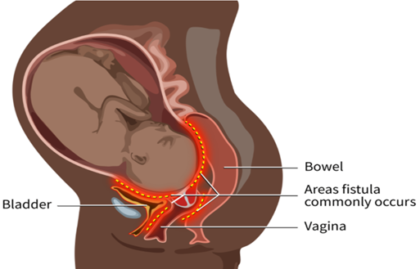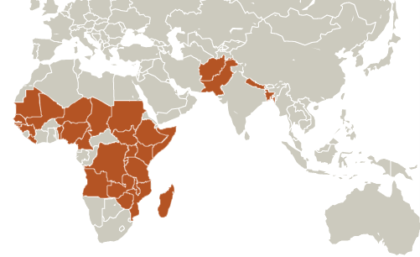Written by: Jinwon Kim
The term Obstetric fistula is unfamiliar to many in the USA. During a prolonged, obstructed labor an opening can develop in the birth canal, between the vagina and the rectum, urethra or bladder. In developed countries with good medical care, fistula is generally prevented by delivering the baby by Cesarean section. Fistulas that do occur usually happen during pelvic surgery and are surgically corrected, and a fistula due to childbirth would be surgically repaired. But in the world’s poorest regions women often do not have access to advanced medical care during childbirth, and an obstetric fistula is a life-destroying tragedy.
This humiliating injury happens often in the world’s poorest regions in the developing countries of Africa and Asia. Obstructed labor can sometimes last for days; this results in the death of the baby in 90% of cases, as well as in obstetric fistula.
When untreated:
- Obstetric fistula leaves a woman unable to control her bladder and bowels, leaking urine, feces or both, creating chronic medical problems.
- Due to odor from constant leakage, the injured woman is shunned by her family and community.
- Because of misperceptions about its cause, the affected woman is often blamed for developing the injury.
- Abandoned by their husbands and families, women with obstetric fistula find it difficult to secure income or support, thereby deepening their poverty.
Figure 1: Areas Obstetric Fistula Commonly Occurs

Numbers: Worldwide, an estimated 50,000 to 100,000 women develop fistula annually and approximately 2 million women currently live with fistula, which is a burden
in almost 60 countries. Its occurrence is a violation of human rights and a reminder of gross inequities. Although preventable and virtually non-existent in developed countries,
fistula continues to afflict many poor women and girls worldwide who lack access to health services.
Source: endfistula.org/SG_Report_Fistula_2018
How Can Obstetric Fistula Be Treated?
The best treatment for obstetric fistula is prevention, but once the opening occurs it can only be cured by surgery. Several charitable organizations are working to help the women affected in developing countries where medical care is difficult to access. Advocates for Women has contributed money annually for several years to The Worldwide Fistula Fund, which performs fistula surgeries in five African countries. Other non-governmental organizations include the Fistula Foundation, working in several African and Asian countries, and Medecins sans Frontieres, which runs “fistula camps” in very remote areas, providing surgery and also psychological counseling to help patients overcome the trauma and isolation they have experienced. Much more extensive resources are necessary, however, to eradicate obstetric fistula.
One Way to Prevent Obstetric Fistula: Prevent Child Marriage
Giving birth is more likely to result in complications when the mother is very young. In fact, complications from pregnancy and childbirth are the leading cause of death among girls between the ages of 15 and 19 in low-income and middle-income countries where child marriage is common. Until about the age of 20, women’s bodies are not fully developed, and they are more likely to have difficult births. People need to be educated about the danger of early childbearing. This is one more reason to encourage delaying marriage and childbearing until women are fully mature. (The late 20s are considered optimum for childbirth). Therefore, discouraging early marriage will contribute to reducing the incidence of obstetric fistula.
How can we discourage child marriage?
Fathers are the role models for their sons and in traditional societies they control their daughters. Men can encourage other men not to marry and impregnate underage girls. Patriarchs can advocate for prevention of child marriage in their societies and countries. Let us educate men about the physical damages caused to girls by early childbearing, as well as the demoralizing lifelong consequences for the survivors of obstetric fistula. Men can be appealed to:
- Have their grandmothers, mothers or sisters suffered from complicated early childbearing?
- Could this injury happen to their wife, sister, daughter?
- Do men understand that an obstetric fistula can destroy a woman’s life?
Child marriage is a problem in the United States as well as in developing countries. See the companion article by Ingrid Naumann.
Figure 2: Countries where Obstetric Fistula Surgeries are Provided by Fistula Foundation

To address fistula: Countries must ensure universal access to sexual and reproductive health services; address socioeconomic inequities; prevent child
marriage and early childbearing; promote universal education, especially for girls; eliminate gender-based violence; and promote and protect the
human rights of women and girls.
Sources: endfistula.org/SG_Report_Fistula_2018 | fistulafoundation.org/where-we-work/
Sources:
Fistula Foundation – https://fistulafoundation.org/
World Wide Fistula Fund – https://worldwidefistulafund.org
UNFPA – Obstetric Fistula – https://unfpa.org
End Fistula – http://www.endfistula.org/sites/default/files/pub-pdf/SG_Report_Fistula_2018_FINAL.pdf
A4W News Group
Editing contributors/collaborators:
Jinwon Kim | Karen Keenan | Vicki Roberts-Gassler | Mary Ann Kirkpatrick
